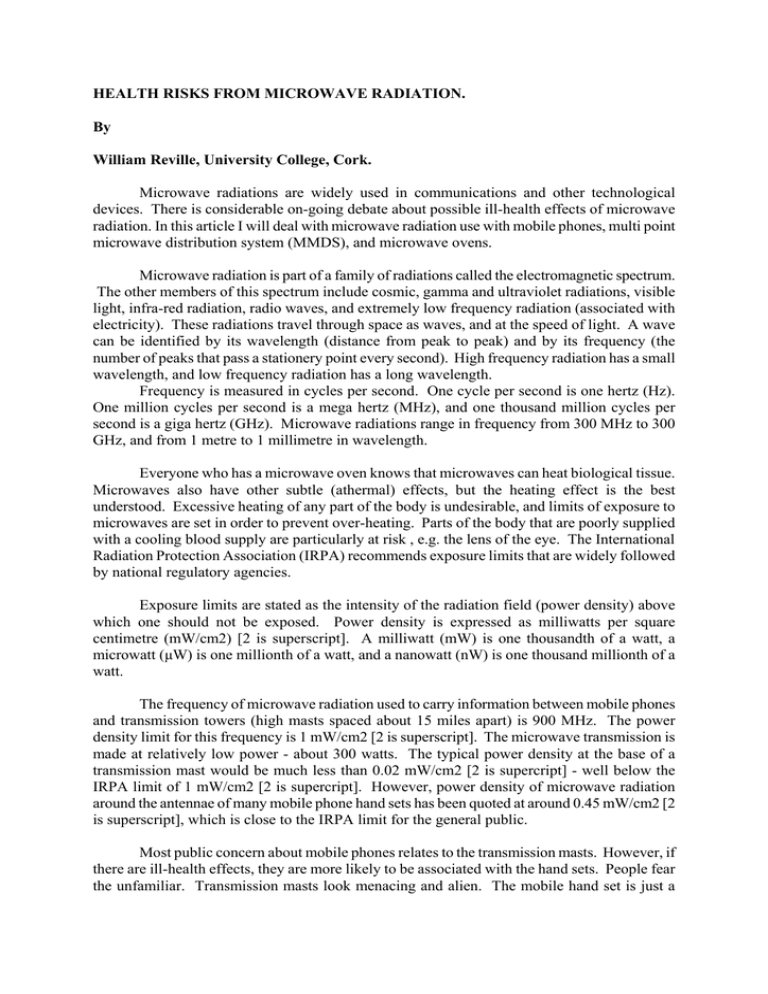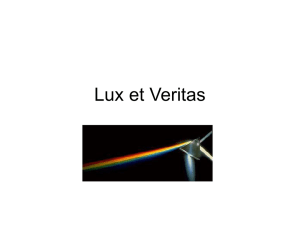HEALTH RISKS FROM MICROWAVE RADIATION. By William Reville
advertisement

HEALTH RISKS FROM MICROWAVE RADIATION. By William Reville, University College, Cork. Microwave radiations are widely used in communications and other technological devices. There is considerable on-going debate about possible ill-health effects of microwave radiation. In this article I will deal with microwave radiation use with mobile phones, multi point microwave distribution system (MMDS), and microwave ovens. Microwave radiation is part of a family of radiations called the electromagnetic spectrum. The other members of this spectrum include cosmic, gamma and ultraviolet radiations, visible light, infra-red radiation, radio waves, and extremely low frequency radiation (associated with electricity). These radiations travel through space as waves, and at the speed of light. A wave can be identified by its wavelength (distance from peak to peak) and by its frequency (the number of peaks that pass a stationery point every second). High frequency radiation has a small wavelength, and low frequency radiation has a long wavelength. Frequency is measured in cycles per second. One cycle per second is one hertz (Hz). One million cycles per second is a mega hertz (MHz), and one thousand million cycles per second is a giga hertz (GHz). Microwave radiations range in frequency from 300 MHz to 300 GHz, and from 1 metre to 1 millimetre in wavelength. Everyone who has a microwave oven knows that microwaves can heat biological tissue. Microwaves also have other subtle (athermal) effects, but the heating effect is the best understood. Excessive heating of any part of the body is undesirable, and limits of exposure to microwaves are set in order to prevent over-heating. Parts of the body that are poorly supplied with a cooling blood supply are particularly at risk , e.g. the lens of the eye. The International Radiation Protection Association (IRPA) recommends exposure limits that are widely followed by national regulatory agencies. Exposure limits are stated as the intensity of the radiation field (power density) above which one should not be exposed. Power density is expressed as milliwatts per square centimetre (mW/cm2) [2 is superscript]. A milliwatt (mW) is one thousandth of a watt, a microwatt (µW) is one millionth of a watt, and a nanowatt (nW) is one thousand millionth of a watt. The frequency of microwave radiation used to carry information between mobile phones and transmission towers (high masts spaced about 15 miles apart) is 900 MHz. The power density limit for this frequency is 1 mW/cm2 [2 is superscript]. The microwave transmission is made at relatively low power - about 300 watts. The typical power density at the base of a transmission mast would be much less than 0.02 mW/cm2 [2 is supercript] - well below the IRPA limit of 1 mW/cm2 [2 is supercript]. However, power density of microwave radiation around the antennae of many mobile phone hand sets has been quoted at around 0.45 mW/cm2 [2 is superscript], which is close to the IRPA limit for the general public. Most public concern about mobile phones relates to the transmission masts. However, if there are ill-health effects, they are more likely to be associated with the hand sets. People fear the unfamiliar. Transmission masts look menacing and alien. The mobile hand set is just a familiar telephone. To be on the safe side, when making or receiving a mobile phone call make sure that the antenna is at least 2.5 cm from your head. Proprietory carrying pouches can now be purchased that significantly reduce the microwave radiation coming from the mobile phone antenna. Your inner ear might be at risk from heating because it has a poor cooling blood supply. Obviously, also, the shorter you keep your mobile phone calls the less microwave radiation you receive. Public concern with the MMDS system centres around the locations of the towers that transmit the 2.66 GHz microwave TV signal. Measurements show that the microwave power density on the ground around these towers is very low and typical power densities (InW) in the closest houses are one million times below the IRPA limit. The microwave oven cooks food using 2.45 Ghz microwaves, and works well with foods that have a liquid water content. The microwave radiation penetrates about 3 centimetres into the food and vibrates water molecules at the microwave frequency. This sets up a friction, producing heat just as you can warm your hands by briskly rubbing them together. When you switch on the microwave oven, heating immediately begins within the bulk of the food, which is why the effect is so fast. In the electric oven, the electric elements must first warm the air which then warms the food from the outside in. This is a much slower process. The fact that microwave cooking depends on liquid water can be illustrated as follows. Take a well-frozen dry (pat it lightly with paper towels to ensure this) piece of ice. Place it in the microwave oven and switch on. The ice will not melt. Microwave ovens are designed to be safe. An interlock instantly shuts off the microwaves if the oven door is opened while the machine is on. Ovens are designed to ensure that power density due to microwave leakage should not exceed 2.5 mW/cm2 [2 is superscript] at any point beyond 2.5 cm from the external casing. There have been reports of higher readings, and of microwave leaks around door-seals. It is important to keep this part of the oven clean and well maintained. It is also best to walk away from the microwave oven when it is in operation. Even if the oven is leaking, the power density of the radiation drops off rapidly with distance from the oven. Much research has been carried out into possible athermal effects of microwave radiation on health. Results of studies to-date allow few precise conclusions to be drawn, but it would seem fair to conclude overall that, if there are ill-health effects, they are small. However, prior to this century, humanity was not exposed to these artificially produced microwave, radiofrequency and extremely low frequency radiations. One or two recent research reports on ill-health effects induced by the use of mobile phones again give cause for concern. People are right to be wary. We should take prudent steps to limit avoidable exposure to these radiations. (This article first appeared in The Irish Times, March 2, 1998.)




